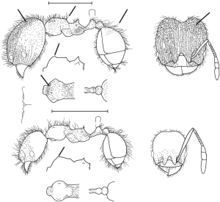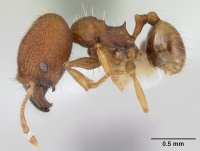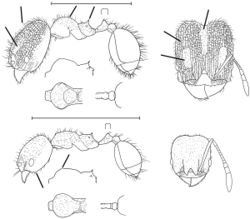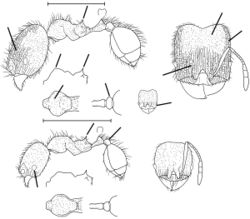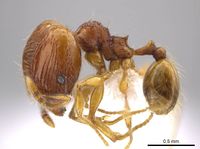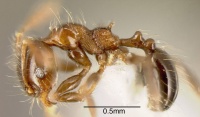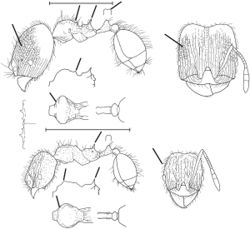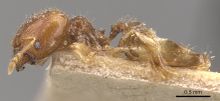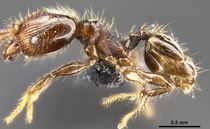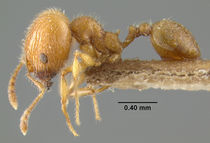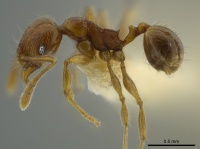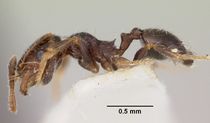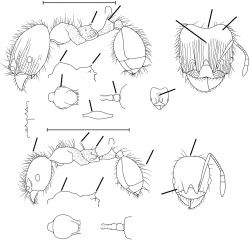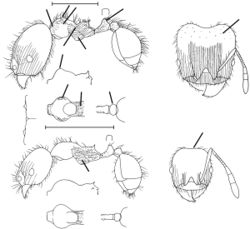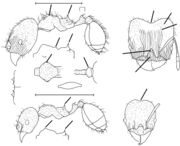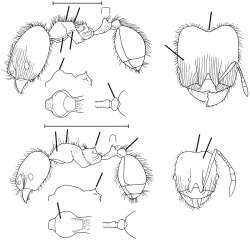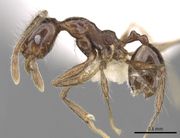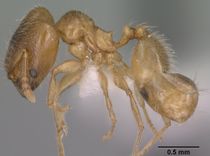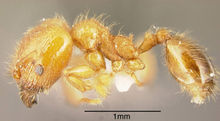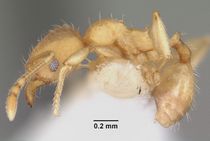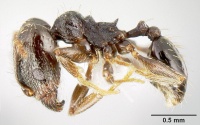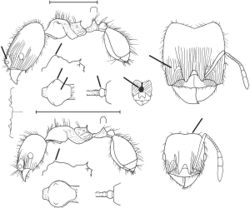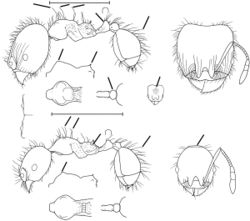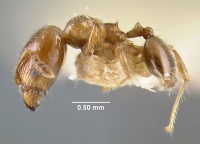Key to Pheidole flavens group
Key to Pheidole flavens group
This worker key is based on: Wilson, E. O. 2003. Pheidole in the New World: A dominant, hyperdiverse ant genus. Harvard University Press, Cambridge, MA.
These species, the great majority of which are instantly recognizable by their small size, vestigial or absent mesonotal convexity, and short, 12-segmented antennae, compose the most speciose and numerically abundant group of the New World Pheidole. Found variously from North Carolina to Argentina, the species collectively are also, with the fallax group, the most widely distributed of the Pheidole groups. One species, Pheidole darlingtoni, is known only from the minor worker and is not included in the key that follows. An apparent endemic of Haiti, it is readily distinguished by its rugoreticulate clypeus and strikingly bicolorous head (whitish yellow and light brown).
You may also be interested in
1
- Major: seen in full-face view, rugoreticulum present on occiput, or at least the occipital lobes, or in bands or patches directly in front of the occipital lobes, or elsewhere on the posterior fifth of the dorsal surface of the head . . . . . 2
- Major: seen in full-face view, no rugoreticulum present on or near the occiput or anywhere on the posterior fifth of the dorsal surface of the head . . . . . 30
2
return to couplet #1
- Major: in full-face view, entire occiput, including the occipital lobes and the dorsal surface of the head between them, is covered by rugoreticulum . . . . . 3
- Major: in full-face view, at least a posteriormost strip of the occiput, or at least a narrow space along the occiput at the midline, or both, is free of rugoreticulum . . . . . 18
3
return to couplet #2
- Major: in full-face view, all of the head behind the level of the posterior margin of the eyes rugoreticulate . . . . . 4
- Major: in full-face view, a substantial space posterior to the eyes or to the frontal lobes, or to both, carinulate but not rugoreticulate . . . . . 5
4
return to couplet #3
- Major: in side view, space immediately laterad to eye is rugoreticulate. Minor: posterior half of head rugoreticulate (Costa Rica, Honduras) . . . . . Pheidole verricula
- Major: in side view, space immediately laterad to eye is carinulate, not rugoreticulate. Minor: posterior half of head foveolate, not rugoreticulate (Argentina, Uruguay) . . . . . Pheidole obtusopilosa
5
return to couplet #3
- Major: anterior third of pronotal dorsum entirely rugoreticulate; mesonotum longitudinally carinulate (Costa Rica) . . . . . Pheidole renae
 Pheidole renae, Minor |
- Major: with possible exception of edges of humeri, anterior third of pronotal dorsum variously transversely carinulate, foveolate or smooth, but not rugoreticulate; mesonotum foveolate or smooth, not carinulate . . . . . 6
6
return to couplet #5
- Major: pronotal dorsum, with the possible exception of the edges of the humeri, entirely smooth and shiny, and lacking carinulae . . . . . 7
- Major: pronotal dorsum at least partly foveolate, and opaque to feebly shiny, often with transverse carinulae in addition . . . . . 8
7
return to couplet #6
- Major: seen from above, the pronotal humeri form obtuse angles, with several short rugulae on the apices; in full-face view, the rugoreticulum covers the occipital lobes, but just barely extends to the midline of the head capsule, as well as along the sides of the head (Bolivia) . . . . . Pheidole infernalis
- Major: seen from above, the pronotal humeri are evenly rounded, with no sculpturing of any kind on the apices; in full-face view, the rugoreticulum covers the entire posterior fourth of the head capsule (Honduras) . . . . . Pheidole ceibana
 Pheidole ceibana, Major |
8
return to couplet #6
- Major: pronotal dorsum entirely covered by (sometimes faint) transverse carinulae . . . . . 9
- Major: carinulae absent from pronotal dorsum or at most limited to its anterior or lateral margins . . . . . 10
9
return to couplet #8
- Major: seen in dorsal-oblique view (mesosoma rotated around long axis 45 degrees from top view), profile of pronotal humerus forms a blunt obtuse angle; in side view posterior ventral quarter of head capsule is smooth and shiny. Minor: seen from above and obliquely, humeri bear acute-angular spines, each with a long hair emerging from its apex (Honduras) . . . . . Pheidole floricola
 Pheidole floricola, Major |
- Major: seen in dorsal-oblique view, profile of humerus is smoothly rounded, in side view posterior ventral quarter of head capsule varies from foveolate and opaque to somewhat shiny. Minor: seen from above and obliquely, humerus bears low, inconspicuous convexities, which lack apical hairs (southern Brazil, Argentina, Paraguay) . . . . . Pheidole lignicola
 Pheidole lignicola, Major |
10
return to couplet #8
- Major: length of eye as great as the distance between the anterior margin of the eye to the front margin of the head capsule directly anterior to it . . . . . 11
- Major: length of eye much less than the distance between the anterior margin of the eye and front margin of the head . . . . . 12
11
return to couplet #10
- Major: seen in dorsal-oblique view (mesosoma rotated around long axis 45 degrees from top view), pronotal humerus forms a right angle; body concolorous brown (Veracruz, Mexico) . . . . . Pheidole xyston
- Major: seen in dorsal-oblique view, humerus a smoothly rounded convexity; body color yellow, except for light brown posterior bands on the gastral tergites and a fuzzy-edged brown spot on the vertex (Choco, Colombia) . . . . . Pheidole lemnisca
12
return to couplet #10
- Major: space between eye and antennal fossa lacks any rugulae or rugoreticulum, and is instead covered by longitudinal and circular carinulae . . . . . 13
- Major: at least some of the space between the eye and antennal fossa occupied by rugoreticulum and/or rugulae . . . . . 14
13
return to couplet #12
- Major: in side view, posterior rear half of head smooth and shiny; lateral margins of postpetiolar node seen from above acute-angular (Veracruz, Mexico) . . . . . Pheidole prolixa (=Pheidole harrisonfordi)
 Pheidole harrisonfordi, Major |
- Major: in side view, posterior rear half of head foveolate and opaque; lateral margins of postpetiolar node seen from above rounded (Costa Rica, Panama) . . . . . Pheidole ruida (=Pheidole harrisonfordi)
14
return to couplet #12
- Major: rugoreticulum confmed to the occiput and space between eye and antennal fossa . . . . . 15
- Major: rugoreticulum extends continuously from occiput down the side of the head all or almost all the way to the eye . . . . . 16
15
return to couplet #14
- Major: antennal scrobes present, although shallow; longitudinal carinulae on the antennallobes extend posteriorly all the way back to meet the rugoreticulum of the occiput (southern Brazil, Peru, Argentina) . . . . . Pheidole sospes
 Pheidole sospes, Major |
- Major: antennallobes absent; longitudinal carinulae of frontal lobes confined to them, leaving almost all of the middle half of the dorsal surface of the head free of carinulae (Costa Rica) . . . . . Pheidole otisi
 Pheidole otisi, Major |
16
return to couplet #14
- Major: antennal scrobes present; pronotal humeri with small patches of rugoreticulum (southeastern Brazil) . . . . . Pheidole termitobia
 Pheidole termitobia, Major |
- Major: antennal scrobes absent; pronotal humeri lacking rugoreticulum, being foveolate only . . . . . 17
17
return to couplet #16
- Major: inner pair of hypos to mal teeth reduced to denticles, much smaller than outer pair. Minor: posterior dorsal half of head lacks carinulae; body blackish brown with metallescent blue reflections (Florida to Texas) . . . . . Pheidole metallescens
 Pheidole metallescens, Major |
- Major: inner pair of hypos to mal teeth strongly developed, as long as outer pair. Minor: longitudinal carinulae cover the posterior dorsal half of the head; head and mesosoma light reddish brown, and waist and gaster dark yellow, with no metallescent reflections anywhere (southeastern United States, Texas) . . . . . Pheidole dentigula
 Pheidole dentigula, Major |
18
return to couplet #2
- Major: in full-face view, rugoreticula near the lateral margins of the dorsal surface of the head extend continuously all the way from the occiput or close to it anteriorly to the level of the eyes . . . . . 19
- Major: in full-face view rugoreticula at or near the occiput are limited to the occipital lobes, or to the nearby space just posterior to the antennal scrobes, or both, but do not also extend along the sides of the head anteriorly all the way to the level of the eyes . . . . . 23
19
return to couplet #18
- Major: pronotal dorsum covered by transverse carinulae. Minor: posterior half of dorsal head surface and all of promesonotal dorsum covered by rugoreticulum (Costa Rica, southern Mexico) . . . . . Pheidole rectitrudis
 Pheidole rectitrudis, Major |
- Major: pronotal dorsum lacking carinulae. Minor: no rugoreticulum present on promesonotal dorsum . . . . . 20
20
return to couplet #19
- Major: antennal scrobes present, and their surface conspicuously lacks carinulae or rugulae, causing it to contrast with the heavily rugoreticulate surface all around the scrobes (Para, Brazil) . . . . . Pheidole peltastes
- Major: antennal scrobes absent; behind and mesad to the frontal lobes, where scrobes occur in many other species, the surface is covered by carinulae, rugulae, or rugoreticulum . . . . . 21
21
return to couplet #20
- Major: in full-face view, central half of the posterior dorsum of the head all the way to the occiput free of carinulae or rugulae (Nicaragua) . . . . . Pheidole rectisentis
- Major: in full-face view, central half of the posterior dorsum of the head covered by longitudinal carinulae or broken, irregular rugulae . . . . . 22
22
return to couplet #21
- Major: carinulae originating on frontal lobes continue posteriorly all the way to the occipital border. Minor: body reddish yellow (Honduras, Belize) . . . . . Pheidole harrisonfordi
 Pheidole harrisonfordi, Major |
- Major: carinulae originating on frontal lobes break up into irregular, fragmented rugulae before reaching the occipital border, and in full-face view leave a thin strip of the occiput anterior to the border smooth (montane Ecuador) . . . . . Pheidole camilla
 Pheidole camilla, Major |
23
return to couplet #18
- Major: in full-face view, the frontal lobes, most of the space between the eyes and antennal fossae, as well as the occipital lobes, rugoreticulate, but most of the large space between the level of the eyes and the level of the occipital lobes is devoid of rugoreticulum, rugulae, or carinulae (montane Veracruz, Mexico) (placed in the fallax group; also keyed out here to ensure identification) . . . . . Pheidole roushae
 Pheidole roushae, Major |
- Major: in full-face view, the longitudinal carinulae extend posteriorly either to the occipital border or to the rugoreticulum just anterior to the border . . . . . 24
24
return to couplet #23
- Major: in full-face view, most or all of the longitudinal carinulae or rugulae originating on the frontal lobes continue unbroken all the way to the occipital border or just anterior to it . . . . . 25
- Major: in full-face view, the longitudinal carinulae or rugulae originating on the frontal lobes are interrupted by rugoreticulum before they reach the occipital border . . . . . 28
25
return to couplet #24
- Major: rugoreticulum extends from the point reached by the tips of the antennal scapes all the way to the outer margins of the occipital lobes; pronotal dorsum covered by transverse carinulae. Minor: anterior half of pronotal dorsum rugoreticulate (Brazil and Misiones, Argentina) (consider also bucolica, placed in provisional synonymy under rudigenis, but a possible distinct species; see rudigenis Diagnosis) . . . . . Pheidole rudigenis
 Pheidole rudigenis, Major |
- Major: rugoreticulum limited to a patch just posterior to the point reached by the tip of the antennal scapes, and does not reach the outer margins of the occipital lobes. Minor: pronotal dorsum lacks rugoreticulum . . . . . 26
26
return to couplet #25
- Major: shallow antennal scrobes present, the surface of their posterior half foveolate but free of carinulae, rugulae, or rugoreticulum; body medium brown. Major and minor: pronotum completely foveolate and opaque (Colombia) . . . . . Pheidole tayrona (=Pheidole sculptior
 Pheidole sculptior, Major |
- Major: antennal scrobe absent and space laterad to posterior part of the frontal lobes filled in with longitudinal carinulae; body yellow or reddish brown. Major and minor: pronotum foveolate or smooth and shiny . . . . . 27
27
return to couplet #26
- Major: rugoreticulum present between eye and antennal fossa; body concolorous yellow. Major and minor: pronotum entirely foveolate and opaque (reticulate-headed form of the species, which also varies through intermediates to a form lacking rugoreticulum on the head; see also couplet 131) (widespread and abundant through the American tropics and, possibly as an adventive, also occurs in Florida; often carried accidentally by commerce) . . . . . Pheidole flavens (in part - also #131)
 Pheidole flavens, Major |
- Major: rugoreticulum not present between eye and antennal fossa; body reddish brown, with head anterior to the eyes medium yellow, and tibiae and tarsi contrasting pale yellow (southern Mexico) . . . . . Pheidole albipes
 Pheidole albipes, Major |
28
return to couplet #24
- Major: longitudinal carinulae arising from the space between the eye and frontal lobe do not extend posteriorly beyond the level of the eye; head elongate (Head Length more than 1.2 X Head Width). Minor: dorsa of head and pronotum foveolate and opaque (Costa Rica) . . . . . Pheidole longinoi
 Pheidole longinoi, Major |
- Major: at least some of the longitudinal carinulae arising between the eye and frontal lobe extend posteriorly all the way to the rugoreticulum located on or near the occiput; head not elongate (Head Length less than 1.1 X Head Width). Minor: dorsa of head and pronotum foveolate and opaque or smooth and shiny . . . . . 29
29
return to couplet #28
- Major: in full-face view, rugoreticulum covers all of the occiput except the center, but extends anteriorly only to within 2 X length of eye of the posterior margin of the antennal scrobes; humeral corners not rugoreticulate. Minor: dorsa of head and pronotum foveolate and opaque (Amazonian Peru) . . . . . Pheidole ademonia
 Pheidole ademonia, Major |
- Major: in full-face view, rugoreticulum approaches occiput only to within an eye length, leaving the remaining strip in front of the occipital border smooth and shiny; humeral corner rugoreticulate. Minor: dorsa of head and pronotum smooth and shiny (montane Dominica, West Indies) . . . . . Pheidole perkinsi
30
return to couplet #1
- Major: in full-face view, head rectangular and very elongate (Head Length 1.6 X longer than Head Width); dorsal head surface often lacking carinulae or rugulae of any kind (Costa Rica to Colombia) . . . . . Pheidole christopherseni
 Pheidole christopherseni, Major |
- Major: in full-face view, head variable in shape among species (Head Length never as much as 1.SX longer than Head Width); carinulae always present and usually abundant, at least in concentric circles around the antennal fossae . . . . . 31
31
return to couplet #30
- Major: rugoreticulum present somewhere on dorsal head surface, even if only as patches between the eyes and antennal fossae or as cross-hatching on the frontal lobes . . . . . 32
- Major: rugoreticulum completely absent from the dorsal surface of the head . . . . . 66
32
return to couplet #31
- Major: in full-face view, entire posterior half of the dorsal surface of the head is covered by longitudinal carinulae or rugulae, or carinulae plus patches of rugoreticulum, with the possible exception of the occiput and surface of the antennal scrobes . . . . . 33
- Major: large portions of the posterior half of the dorsum of the head, such as most of the sides of the head, not just the occiput and antennal scrobes, are free of carinulae, rugulae, and rugoreticulum . . . . . 49
33
return to couplet #32
- Major: in full-face view, carinulae or rugulae on the dorsal head surface extend posteriorly all the way to the occipital border . . . . . 34
- Major: in full-face view, carinulae or rugulae on the dorsal head surface do not extend all the way to the occipital border; all or at least part of the occipital lobes lack them . . . . . 39
34
return to couplet #33
- Major: prominent humeral “sharkfin” horns present on pronotum, projecting beyond the lateral margins of the rest of the pronotum even when viewed from directly above, their apices forming acute angles (Amazonian Peru) . . . . . Pheidole gilva
- Major: humeral horns absent; humeral margins form evenly rounded convexities with no prominent protrusions . . . . . 35
35
return to couplet #34
- Major: anterior third of pronotum lacking carinulae and rugoreticulum . . . . . 36
- Major: anterior third of pronotum covered by transverse carinulae and patches of rugoreticulum . . . . . 37
36
return to couplet #35
- Major: head broader than long; in full-face view, it expands posteriorly to reach maximum width at the occiput; conspicuously bicolored, with mesosoma, waist, and part of head brown, and rest of body yellow; pronotal spine thick and as long as the basal face of the propodeum anterior to it (Dominican Republic) . . . . . Pheidole harlequina
 Pheidole harlequina, Major |
- Major: head square-shaped and exactly as broad as long; body and head concolorous yellow; propodeal spine medium-wide and only one-third as long as the basal face of the propodeum (Guatemala) (see also subreticulata) . . . . . Pheidole breviscapa (= Pheidole perpusilla)
 Pheidole perpusilla, Major |
37
return to couplet #35
- Major: antennal scrobes absent; body reddish brown (Argentina) . . . . . Pheidole heterothrix
 Pheidole heterothrix, Major |
- Major: antennal scrobes present; body yellow or brown . . . . . 38
38
return to couplet #37
- Major: rugoreticulum on dorsal head surface limited to the space between the eye and the antennal fossa (southern Mexico, Costa Rica) (also, check mittermeieri) . . . . . Pheidole glomericeps
 Pheidole glomericeps, Major |
- Major: rugoreticulum on dorsal head surface limited to small space immediately behind the antennal scrobe (Colombia) . . . . . Pheidole charazana
 Pheidole charazana, Major |
39
return to couplet #33
- Major and minor: in side view, profile of occiput bears several clavate hairs, the pilosity of the promesonotal dorsum consists almost entirely of several pairs of clavate hairs, and several more clavate hairs occur on the dorsa of the petiolar and postpetiolar nodes (Texas) . . . . . Pheidole constipata
 Pheidole constipata, Major |
- Major and minor: pilosity of occiput, promesonotum, and waist consists of abundant, non-clavate hairs . . . . . 40
40
return to couplet #39
- Major: seen from above and obliquely, pronotal humerus angulate or subangulate . . . . . 41
- Major: seen from above and obliquely, pronotal humerus smoothly rounded . . . . . 43
41
return to couplet #40
- Major: humeral angle, viewed from above and obliquely, is acute; in side view, frontal lobe extends forward as a prominent, right-angular flange (Costa Rica to Brazil, Peru, and Ecuador) (placed in the tristis group; also keyed out here to ensure identification) . . . . . Pheidole cramptoni
 Pheidole cramptoni, Major |
- Major: humeral angle obtuse; frontal lobe in side view rounded and not protuberant . . . . . 42
42
return to couplet #41
- Major: antennal scrobes present; promesonotal dorsum and anterior half of first gastral tergite foveolate and opaque (Tamaulipas, Mexico) . . . . . Pheidole rectiluma (=Pheidole bilimeki)
 Pheidole bilimeki, Major |
- Major: antennal scrobes absent; promesonotal dorsum and all of first gastral tergite smooth and shiny (Costa Rica to Amazonian Peru) . . . . . Pheidole tennantae (in part - also #150)
 Pheidole tennantae, Major |
43
return to couplet #40
- Major: rugoreticulum begins at eye level and extends posteriorly to about halfway between the level of the posterior margin of the eye and the level of the occiput, and it also extends to the space ventral to ("behind") the eye (Colombia) . . . . . Pheidole quadriceps
- Major: rugoreticulum limited to the space between the eye and antennal fossa . . . . . 44
44
return to couplet #43
- Major: anterior half of pronotal dorsum covered with transverse carinulae . . . . . 45
- Major: pronotal dorsum entirely free of carinulae . . . . . 46
45
return to couplet #44
- Major: seen from above, postpetiolar node oval in outline, and sides of the node mostly smooth and shiny. Minor: longitudinal carinulae present behind (ventral to) the eye and those immediately mesad to the eye extend past the posterior margin of the eye by an eye's length; a small amount of reticulum present between eye and antennal fossa (West Indies, introduced into U. S. Gulf States) . . . . . Pheidole moerens
 Pheidole moerens, Major |
- Major: seen from above, postpetiolar node trapezoidal in shape, widest near anterior border, and its sides foveolate and opaque. Minor: no carinulae present ventral to eye, and those immediately mesad to the eye do not extend an eye's length past the posterior margin of the eye; no reticulum present on head (Argentina) . . . . . Pheidole bruchella
 Pheidole bruchella, Major |
46
return to couplet #44
- Major: in side view, a separate mesonotal convexity well developed; seen from above, lateral margins of postpetiolar node angulate (Amazonian Peru) . . . . . Pheidole sabella
- Major: in side view, mesonotal convexity not separately developed, the promesonotal profile forming a single smooth curve; from above, lateral margins of postpetiolar node rounded . . . . . 47
47
return to couplet #46
- Major: lower half of mesopleuron foveolate, opaque, and with longitudinal rugulae; occiput bears scattered conspicuous foveae; head bicolored, dark yellow anterior to the eyes and brown behind (Venezuela) . . . . . Pheidole pariana
- Major: lower half of mesopleuron smooth and shiny; occiput lacking foveae; head concolorous yellow or brown . . . . . 48
48
return to couplet #47
- Major: many hairs along dorsal profiles of promesonotum and first gastral tergite 2 X eye length; in side view, space between metanotal groove and propodeal spiracle longitudinally rugulate (Amazonian Peru and Ecuador) . . . . . Pheidole caracalla
 Pheidole caracalla, Major |
- Major: hairs along dorsal profiles of promesonotum and first gastral tergite at most about 1 X eye length; in side view, rugulae do not cover the space between the metanotal groove and propodeal spiracle (St. Vincent and Puerto Rico) . . . . . Pheidole orbica
 Pheidole orbica, Major |
49
return to couplet #32
- Major and minor: pronotal dorsum completely covered by coarse rugoreticulum (Costa Rica) . . . . . Pheidole carinata
 Pheidole carinata, Major |
- Major and minor: pronotal dorsum lacking rugoreticulum . . . . . 50
50
return to couplet #49
- Major: pronotal dorsum completely covered by transverse carinulae (Costa Rica) . . . . . Pheidole brachyops
 Pheidole brachyops, Major |
- Major: pronotal dorsum free of carinulae, or, at most, a few carinulae occur on the anteriormost strip, or humeri, or both . . . . . 51
51
return to couplet #50
- Major: rugoreticulum occurs as a band across the dorsum of the head from eye to eye and across the frontal lobes without a break; in side view, posteriormost carinulae departing from anterior margin of the eye travel obliquely downward toward the lower ventral corner of the head (Argentina) . . . . . Pheidole carapunco
- Major: rugoreticulum interrupted in the center of the dorsum of the head by the longitudinal carinulae of the frontal lobes; in side view, carinulae departing from anterior margin of the eye travel straight forward to the anterior clypeal border or even slightly upward toward the dorsal surface of the head . . . . . 52
52
return to couplet #51
- Major: in side view, rugoreticulum completely surrounds the eye and continues ventrally across the gena to the lower margin of the head (Campeche, Mexico) . . . . . Pheidole dumicola
- Major: in side view, rugoreticulum does not extend all the way around the eye or onto the gena . . . . . 53
53
return to couplet #52
- Major: seen from above, margins of postpetiolar node form spines or at least acute angles . . . . . 54
- Major: seen from above, the postpetiolar node forms an oval or trapezoid, its margins either round or obtuse-angular . . . . . 60
54
return to couplet #53
- Major: seen from above, margins of postpetiolar node taper into spines, and the humeri form acute angles that project slightly beyond the margins of the rest of the pronotum beneath them (Arizona) . . . . . Pheidole furtiva
 Pheidole furtiva, Major |
- Major: seen from above, margins of postpetiolar node are acute-angular but not tapered into spines; humeri do not extend as acute angles beyond margins of rest of pronotum . . . . . 55
55
return to couplet #54
- Major: hypostomum bearing 3 teeth; first gastral tergite partly shagreened and opaque . . . . . 56
- Major: hypostomum bearing 4-5 teeth; first gastral tergite completely smooth and shiny . . . . . 57
56
return to couplet #55
- Major: in side view, posterior half of ventral surface of head foveolate and opaque. Minor: in side view, propodeal spine more than half as long as the basal propodeal face anterior to it (Oaxaca, Mexico) . . . . . Pheidole oaxacana
- Major: in side view, posterior half of ventral surface of head smooth and shiny. Minor: in side view, propodeal spine only one-third as long as the basal propodeal face anterior to it (Veracruz, Mexico) . . . . . Pheidole scabriventris (=Pheidole nebulosa)
 Pheidole nebulosa, Major |
57
return to couplet #55
- Major: shallow antennal scrobes present (Arizona) . . . . . Pheidole juniperae
 Pheidole juniperae, Major |
- Major: shallow antennal scrobes absent . . . . . 58
58
return to couplet #57
- Major: posterior half of dorsal surface of head covered by widely spaced, conspicuous, coarse, and piligerous punctures (Mexico City) . . . . . Pheidole tragica
 Pheidole tragica, Major |
- Major: posterior half of dorsal surface of head lacks conspicuous piligerous punctures . . . . . 59
59
return to couplet #58
- Major: dorsal surface of head bicolored, with occiput and anterior strip of head surface yellow and middle section light brown. Minor: occiput foveolate and opaque to feebly shiny; carinulae immediately mesad to eye extend posteriorly past eye halfway to occipital border (southeastern Mexico) . . . . . Pheidole chalca
 Pheidole chalca, Major |
- Major: dorsal surface of head concolorous reddish yellow. Minor: occiput smooth and shiny; carinulae mesad to eye do not extend posteriorly past the eye (Oaxaca, Mexico) . . . . . Pheidole mixteca
60
return to couplet #53
- Major: concolorous yellow, except for a unique “mask” of light brown that extends across all the head exclusive of the occipital lobes and the genae anterior to the eyes. Minor: nuchal collar present (Costa Rica) . . . . . Pheidole nasutoides
 Pheidole nasutoides, Major |
- Major: species variously yellow to brown; head concolorous or, if bicolored, the contrasting zones are in different shades of brown. Minor: nuchal collar present or absent . . . . . 61
61
return to couplet #60
- Major: seen from the side, what appears to be the profile of the metanotal dorsum is a distinct convexity, which separates the mesonotal convexity from the low rise of the propodeal basal face. Minor: nuchal collar present (Santa Catarina, Brazil) . . . . . Pheidole flavida
 Pheidole flavida, Major |
- Major: seen from the side, profile of meta notal dorsum is a narrow concave groove, as typical for the genus, with no convexity. Minor: nuchal collar absent . . . . . 62
62
return to couplet #61
- Major: seen from the side, profile of lower surface of postpetiole protrudes downward at its anterior end as a blunt right angle; transverse carinulae partly cover anterior third of the pronotal dorsum (Venezuela) . . . . . Pheidole tachirana
- Major: seen from the side, profile of lower surface of postpetiole straight or slightly concave, not protruding anteriorly as a lobe; at most, very short carinulae occur on the tips of the humeri . . . . . 63
63
return to couplet #62
- Major: in full-face view, posterior third of head capsule bears widely spaced, conspicuous piligerous foveae (Amazonian Peru and Ecuador) . . . . . Pheidole amazonica
 Pheidole amazonica, Major |
- Major: in full-face view, posterior third of head capsule lacks piligerous foveae . . . . . 64
64
return to couplet #63
- Major: seen in dorsal-oblique view (mesosoma rotated around long axis 45 degrees from top view), pronotal humerus raised as a discrete lobe high above the remainder of the promesonotum (Colombia, Brazil, Peru) . . . . . Pheidole tambopatae
- Major: seen in dorsal-oblique view, humerus does not form a distinct lobe, but instead its profile continues with that of the remainder of the promesonotum to form a smooth semicircle or at most a low, slightly separate lobe . . . . . 65
65
return to couplet #64
- Major: a broad rugoreticulum stretches from the eye to the antennal fossa; posterior third of dorsal surface of head foveolate and opaque. Minor: dorsa of head and pronotum foveolate and opaque. Major and minor: reddish yellow (Trinidad) . . . . . Pheidole trinitatis
- Major: rugoreticulum on dorsal surface of head limited to very small patches next to the outer circular carinulae of the antennal fossa; posterior third of dorsal surface of head smooth and shiny. Minor: head and pronotum smooth and shiny. Major and minor: light to medium brown (Venezuela) . . . . . Pheidole hedlundorum
66
return to couplet #31
- Major: in full-face view, carinulae and/or rugulae cover all of the posterior half of the dorsal surface of the head up to and including the occipital border with the possible exception of part of the antennal scrobes . . . . . 67
- Major: in full-face view, at least lateral parts of the occipital lobes or sides of the posterior dorsal surface of the head free of carinulae and rugulae . . . . . 87
67
return to couplet #66
- Major: in full-face view, longitudinal carinulae traveling along the lateral thirds of the dorsum of the head tum inward as they approach close to the occiput and curve at least part way across the occipital lobes toward the midline . . . . . 68
- Major: in full-face view, longitudinal carinulae traveling along the lateral thirds of the dorsum of the head either continue as straight lines to the occipital border or turn outward as they approach close to the occipital lobes . . . . . 71
68
return to couplet #67
- Major: inward-curving carinulae on occiput meet one another at the midline . . . . . 69
- Major: inward-curving carinulae on occiput approach one another from both sides of the head but do not meet at the midline . . . . . 70
69
return to couplet #68
- Major: in side view mesonotal convexity absent; posterior dorsal profile of head convex. Minor: promesonotum smooth and shiny (Sao Paulo, Brazil) . . . . . Pheidole borgmeieri
- Major: in side view mesonotal convexity present; posterior dorsal profile of head slightly concave. Minor: promesonotum foveolate and opaque (Veracruz, Mexico) . . . . . 70
70
return to couplet #69 return to couplet #68
- Major: in side view, dorsal profile of promesonotum flat most of its length until it descends almost vertically to the metanotal groove; seen from above, lateral margins of postpetiolar node rounded. Minor: in full-face view, carinulae mesad to the eye continue posteriorly to near the occipital border (Mexico to Amazonian Peru) . . . . . Pheidole striaticeps
 Pheidole striaticeps, Major |
- Major: in side view, promesonotal dorsal profile strongly convex and descends very gradually to the metanotal groove; seen from above, lateral corners of postpetiolar node right-angulate. Minor: in full-face view, there are no carinulae mesad to the eye (Amazonian Peru and Ecuador) . . . . . Pheidole cardiella
 Pheidole cardiella, Major |
71
return to couplet #67
- Major: in full-face view, longitudinal carinulae originating on the frontal lobes curve strongly outward (laterad) from each other as they cross the occipital lobes (Cuba) . . . . . Pheidole neolongiceps
- Major: in full-face view, longitudinal carinulae traveling over the posterior dorsum continue straight or weakly outwardly curving until they reach the occipital margin or rugulae on the margin . . . . . 72
72
return to couplet #71
- Major and minor: in side view, the propodeal spine is as long as or longer than the basal propodeal face anterior to it . . . . . 73
- Major and minor: in side view, the propodeal spine is at most only half as long as the basal propodeal face anterior to it . . . . . 74
73
return to couplet #72
- Major: humeri bluntly right-angular and covered by short carinulae; head concolorous yellow; first gastral tergite smooth and shiny (Colombia) (placed in the punctatissima group; also keyed out here to ensure identification) . . . . . Pheidole cataphracta
 Pheidole cataphracta, Major |
- Major: humeri smoothly rounded and free of carinulae; head in full-face view strikingly bicolored, with occiput and center of clypeus medium brown and rest of the surface brownish yellow; first gastral tergite almost completely shagreened and opaque (Dominican Republic) ) . . . . . Pheidole drepanon (in part - also #116)
 Pheidole drepanon, Major |
75
return to couplet #74
- Major: in full-face view, the carinulae laterally adjacent to the circular carinulae of the antennal fossae travel obliquely away from the circular carinulae to the eye and margin of the head on either side of the eye (Texas) . . . . . Pheidole mera
 Pheidole mera, Major |
- Major: in full-face view, the carinulae laterally adjacent to the circular carinulae of the antennal fossae travel parallel to the long axis of the head past the eye and continue straight for most or all the entire length of the head . . . . . 76
76
return to couplet #75
- Major: pronotal dorsum lacks carinulae . . . . . 77
- Major: pronotal dorsum covered at least in part by transverse carinulae . . . . . 79
77
return to couplet #76
- Major: in dorsal-oblique view (mesosoma rotated around long axis 45 degrees from top view), the pronotal humerus is smoothly rounded and forms part of the circular profile of the entire promesonotum (Colombia) . . . . . Pheidole servilia
- Major: in dorsal-oblique view, the humerus forms a blunt obtuse angle . . . . . 78
78
return to couplet #77
- Major: in full-face view, tip of antenna touches the lateral margin of the head less than halfway from the level of the eye to the level of the occipital border; antennal scrobe present (Costa Rica, Mexico) . . . . . Pheidole striaticeps
 Pheidole striaticeps, Major |
- Major: in full-face view, tip of antenna touches the lateral margin of the head three-fourths the distance from the level of the eye to the level of the occiput; antennal scrobe absent (Costa Rica) . . . . . Pheidole onyx
 Pheidole onyx, Major |
79
return to couplet #76
- Major: lower half of sides of pronotum lined with longitudinal carinulae . . . . . 80
- Major: lower half of sides of pronotum lacking carinulae . . . . . 82
80
return to couplet #79
- Major: antennal scrobes present; mesopleuron at least partly rugulose (Bolivia) . . . . . Pheidole mittermeieri
- Major: antennal scrobes absent; mesopleuron smooth or foveolate (southeastern Brazil) . . . . . 81
81
return to couplet #80
- Major: mesonotal dorsum carinulate . . . . . Pheidole tetrica
 Pheidole tetrica, Major |
- Major: mesonotal dorsum bearing scattered, fragmented rugulae, lacking carinulae (Mato Grosso, Brazil) . . . . . Pheidole subreticulata
 Pheidole subreticulata, Major |
82
return to couplet #79
- Major: antennal scrobes present and free of carinulae . . . . . 83
- Major: antennal scrobes absent, or, if present, entirely lined with longitudinal carinulae . . . . . 85
83
return to couplet #82
- Major: pronotum smooth and shiny. Minor: longitudinal carinulae immediately mesad to the eye exceeding its posterior margin by 1 X the eye length or more (Texas) . . . . . Pheidole nuculiceps
 Pheidole nuculiceps, Minor |
- Major: pronotum foveolate and opaque. Minor: longitudinal rugulae immediately mesad to the eye not exceeding the posterior margin of the eye . . . . . 84
84
return to couplet #83
- Major: in full-face view, longitudinal carinulae originating on the frontal lobes become indistinct along the occipital border, and along their entire length the interspaces separating them are only sparsely foveolate and weakly shiny to subopaque (Panama) . . . . . Pheidole kuna
- Major: in full-face view, longitudinal carinulae originating on the frontal lobes continue strongly all the way to the occipital border; the interspaces along the last fourth of their length are heavily foveolate and opaque (Amazonian Brazil and Peru) . . . . . Pheidole pholeops
85
return to couplet #82
- Major: sides of pronotum entirely smooth and shiny (Bolivia, Brazil, Peru) . . . . . Pheidole asperithorax
 Pheidole asperithorax, Major |
- Major: sides of pronotum largely foveolate and opaque . . . . . 86
86
return to couplet #85
- Major: in side view, carinulae originating from center of dorsal (mesal, on side toward antennal fossa) margin of eye descend obliquely and forward to the antennal fossa; seen from above, lateral margins of postpetiolar node rounded (southern Brazil) . . . . . Pheidole victima
 Pheidole victima, Major |
- Major: in side view, carinulae originating from center of dorsal (mesal) margin of eye descend parallel to the long axis of the head to the anterior margin of the head; seen from above lateral margins of postpetiolar node angulate (Argentina) . . . . . Pheidole alacris
 Pheidole alacris, Major |
87
return to couplet #66
- Major: in full-face view, longitudinal carinulae present on frontal lobes, and circular carinulae surround the antennal fossae, but carinulae and rugulae are entirely absent from the rest of the head; extremely small (Head Width 0.6 mm) (Amazonian Peru) . . . . . Pheidole micridris
- Major: in full-face view, longitudinal carinulae present between eye and circular carinulae around the antennal fossae, and often elsewhere on the head as well; Head Width rarely if ever less than 0.7 mm . . . . . 88
88
return to couplet #87
- Major: head shaped like an arrowhead: in full-face view, with mandibles included, head is almost perfectly heart-shaped, and in side view the head capsule is elongate, very flattened, and subrectangular, i.e., the dorsal profile straight, the ventral profile very feebly convex, almost straight, and the length of the capsule in side view over 2.5 X its width at transect of maximum depth (Costa Rica) . . . . . Pheidole sagittaria
 Pheidole sagittaria, Major |
- Major: head shaped unlike arrowhead; in side view the head capsule is only 2 X as long as or less than its width at transect of maximum width . . . . . 89
89
return to couplet #88
- Major: in side view, carinulae or rugulae originating on the dorsal (mesal, facing antennal fossa) margin of the eye descend obliquely and anteriorly to the edge of the antennal fossa . . . . . 90
- Major: in side view, carinulae or rugulae originating on the dorsal (mesal) margin of the eye descend parallel to the long axis of the head or in a slightly oblique direction to the anterior margin of the head capsule . . . . . 94
90
return to couplet #82
- Major: in side view, distance from eye to anterior margin of the head capsule is less than the eye length; linear sculpture traveling from the dorsal margin of the eye (and just behind it) to the antennal fossa consists mostly of rugulae (wavy lines) (Costa Rica, Panama) . . . . . Pheidole olsoni
 Pheidole olsoni, Major |
- Major: in side view, distance from eye to anterior margin of head capsule is 1.5 X the eye length or more; linear sculpture from the dorsal margin of the eye (and just behind it), to the antennal fossa consists entirely of carinulae (nonwavy lines) . . . . . 91
91
return to couplet #90
- Major: pronotal dorsum smooth and shiny . . . . . 92
- Major: pronotal dorsum foveolate and opaque . . . . . 93
92
return to couplet #91
- Major: mesopleuron covered by longitudinal carinulae; a shallow faint antennal scrobe present. Minor: in full-face view, posterior third of head smooth and shiny (Venezuela) . . . . . Pheidole styrax
- Major: mesopleuron smooth and shiny, free of carinulae; antennal fossa absent. Minor: in full-face view, posterior third of head covered by faint longitudinal carinulae, and also foveolate and opaque (para, Brazil) . . . . . Pheidole bidens
 Pheidole bidens, Major |
93
return to couplet #91
- Major: in full-face view, carinulae immediately mesad to eye extend posteriorly beyond eye to more than halfway the distance from the level of the posterior margin of the eye to the level of the occipital lobe; seen from above, postpetiolar node trapezoidal, with greatest width at the anterior border (Veracruz, Mexico) . . . . . Pheidole tillandsiarum
- Major: in full-face view, carinulae immediately mesad to eye extend posteriorly beyond eye only to about one-third the distance from the level of the posterior margin of the eyes to the level of the occipital lobes; seen from above, postpetiolar node is widest at the center (Colombia) . . . . . Pheidole grex
94
return to couplet #89
- Major: seen from directly above, humeri extend well beyond the lateral profile of the pronotum beneath them, forming prominent acute angles; seen from above and obliquely, the humerus and mesonotal convexity form equal-sized and small but conspicuous teeth. Minor: seen in side view, the corner of the basal and posterior faces of the mesonotal dorsum forms an acute tooth, and the posterior mesonotal face descends in a nearly vertical line that is almost as long as the basal face posterior to it (Costa Rica, Panama) . . . . . Pheidole multispina
 Pheidole multispina, Major |
- Major: seen from directly above, humeri do not project beyond the lateral profile of the pronotum beneath them; seen from above and obliquely, the humerus and mesonotal convexity do not form equal-sized teeth. Minor: seen from the side the mesonotal posterior face does not descend in a long vertical line as described above . . . . . 95
95
return to couplet #94
- Major: seen in dorsal-oblique view (mesosoma rotated around long axis 45 degrees from top view), the humerus is extended as a large acute or right angle or lobe that projects more than 2 X the height above the line of the rearmost convexity of the promesonotum behind it relative to the metanotal groove . . . . . 96
- Major: seen in dorsal-oblique view, humerus either is smoothly continuous with the rest of the promesonotum or forms a relatively low convexity or rounded obtuse angle 2 X or less higher than the line of the rearmost convexity of the promesonotum behind it, relative to the metanotal groove . . . . . 107
96
return to couplet #95
- Major: seen from above, lateral margins of postpetiolar node taper into spines or acute angles; at least part of the anterior half of median strip of first gastral tergite shagreened and opaque (Mexico, Central America, northern South America, West Indies) . . . . . 97
- Major: seen from above, postpetiolar node oval or trapezoidal, with rounded lateral or obtusely angular margins; first gastral tergite entirely smooth and shiny . . . . . 98
97
return to couplet #96
- Major: lateral postpetiolar margins spinose; head lacking brown spot in center of dorsum. Minor: first gastral tergite shagreened and opaque (widespread, Mexico to Central America, and West Indies) (see also floridana and stomachosa, couplet 156) . . . . . Pheidole bilimeki
 Pheidole bilimeki, Major |
- Major: lateral postpetiolar margins acute-angulate, but not drawn into spines; brown spot present in center of head dorsally. Minor: first gastral tergite almost entirely smooth and shiny (Costa Rica) (see also flavifrons) . . . . . Pheidole daphne
 Pheidole daphne, Major |
98
return to couplet #96
- Major: hypostomal border with 2 teeth; propodeal spiracle very large, wider than the base of the propodeal spine viewed from the side and half as wide as the length of the eye (Amazonian Bolivia, Brazil, and Peru) (placed in the tristis group; also keyed out here to ensure identification) . . . . . Pheidole polita
 Pheidole polita, Major |
- Major: hypostomal border with 4-5 teeth; propodeal spiracle not as wide as base of the propodeal spine seen from the side or half the eye length . . . . . 99
99
return to couplet #98
- Major: promesonotal dorsum entirely foveolate and opaque . . . . . 100
- Major: promesonotal dorsum mostly or entirely smooth and shiny . . . . . 101
100
return to couplet #99
- Major: seen from above, postpetiolar node oval and foveolate. Minor: carinulae absent from head directly anterior to eye and from all but the lateral margins of the frontal lobes (Colombia, Brazil) . . . . . Pheidole arhuaca (in part - also #162)
 Pheidole arhuaca, Major |
- Major: seen from above, postpetiolar node trapezoidal, with obtusely angular lateral margins, and smooth and shiny. Minor: carinulae present anterior to eye and over all the frontal lobes (Colombia) . . . . . Pheidole mincana (=Pheidole boliviana)
 Pheidole boliviana, Major |
101
return to couplet #99
- Major: pronotal dorsum completely free of carinulae . . . . . 102
- Major: at least anterior fourth of pronotal dorsum partly or entirely covered with transverse carinulae . . . . . 104
102
return to couplet #100
- Major: side of pronotum completely foveolate and opaque. Minor: dorsal surfaces of head and pronotum completely foveolate and opaque (Costa Rica) . . . . . Pheidole caulicola
 Pheidole caulicola, Major |
- Major: side of pronotum completely smooth and shiny. Minor: dorsal surfaces of head and pronotum completely smooth and shiny . . . . . 103
103
return to couplet #102
- Major: head elongate (Head Length 1.3 X Head Width) and lacks ocelli; seen from above and obliquely, promesonotal profile forms a large triangle, with the base only slightly longer than the sides, and lacking a tooth (Texas) . . . . . Pheidole humeralis
 Pheidole humeralis, Major |
- Major: head ordinary in proportion (Head Length 1.1 X Head Width); median ocellus present; seen from above and obliquely, promesonotal profile not triangular, instead surmounted by a small obtusely angular tooth (Ecuador) . . . . . Pheidole viriosa (in part - also #167)
104
return to couplet #101
- Major: longitudinal carinulae on frontal lobes extend posteriorly past the level of the posterior margin of the eye by only 1.5 X the eye length. Minor: in full-face view, head narrowed strongly at occiput; occipital margin straight, and followed by nuchal collar (Costa Rica) . . . . . Pheidole erratilis
 Pheidole erratilis, Major |
- Major: longitudinal carinulae on frontal lobes extend posteriorly past the level of the posterior margin of the eye by at least 2 X the eye length. Minor: in full-face view, occiput broad and concave, and lacks nuchal collar. . . . . . 105
105
return to couplet #104
- Major: humeri with small patches of rugoreticulum; in full-face view, head weakly bicolored, with dark yellow anterior half and light brown posterior half (Mexico, Ecuador) . . . . . Pheidole nitidicollis ((in part - also #130)
 Pheidole chalcoides, Major |
- Major: humeri lack patches of rugoreticulum; head concolorous redclish yellow or light brown or weakly bicolored . . . . . 106
106
return to couplet #105
- Minor: seen in dorsal-oblique view, apex of humerus forms a sharkfm, right-angular lobe; carinulae immediately mesad to eye extend posteriorly only about an eye length (Brazil, Bolivia, Venezuela) . . . . . Pheidole schmalzi
 Pheidole schmalzi, Major |
- Minor: seen in dorsal-oblique view, profile of humerus is prominent but its apex is obtuse, not a right-angular sharkfin; carinulae immediately mesad to the eye extend posteriorly 2 X or more than the length of the eye (Costa Rica) . . . . . Pheidole angulifera
 Pheidole angulifera, Major |
107
return to couplet #95
- Major: at least part of the mesopleuron covered by rugulae or rugoreticulum . . . . . 108
- Major: mesopleuron smooth, or foveolate, or carinulate, but not rugulate or rugoreticulate . . . . . 111
108
return to couplet #107
- Major: lower half of mesopleuron completely covered by rugoreticulum and irregular rugulae (Costa Rica) . . . . . Pheidole petersoni (=Pheidole erratilis)
 Pheidole erratilis, Major |
- Major: lower half of mesopleuron completely smooth or covered at most (and then only partly) by longitudinal carinulae . . . . . 109
109
return to couplet #108
- Major: in full-face view, carinulae covering frontal lobes extend posteriorly to within one to 2 eye-lengths of the occiput (French Guiana) . . . . . Pheidole moffetti
- Major: in full-face view, carinulae covering frontal lobes extend to no more than halfway between the level of the eyes and level of the occipital margin . . . . . 110
110
return to couplet #109
- Major: humeri rugoreticulate; lower half of mesopleuron completely covered by longitudinal carinulae; posterior third of dorsum of head capsule dotted by sparse but conspicuous foveate (Panama) . . . . . Pheidole umphreyi
- Major: humeri lacking rugoreticulae; lower half of mesopleuron smooth; posterior third of dorsum of head capsule lacks foveae (Brazil, in nests of Dinoponera) (see also quercicola) . . . . . Pheidole dinophila
111
return to couplet #107
- Major: in side view, propodeal spine is greatly reduced, its height no greater than the width of the propodeal spiracle and its apex forming a right or obtuse angle . . . . . 112
- Major: in side view, propodeal spine is well developed, longer than the width of the propodeal spiracle and its apex, forming an acute angle . . . . . 112
112
return to couplet #111
- Major: in full-face view, carinulae originating on frontal lobes extend posteriorly to midway between the level of the eyes and level of the occipital margin; anterior half of the pronotal dorsum covered by transverse carinulae (Costa Rica) . . . . . Pheidole cerina
 Pheidole cerina, Major |
- Major: in full-face view, carinulae originating on frontal lobes, if present, do not extend posteriorly more than a quarter of the distance between the level of the eyes and the level of the occiput; pronotal dorsum lacks carinulae . . . . . 113
113
return to couplet #112
- Major: in full-face view, longitudinal carinulae completely cover the frontal lobes, and others originate from the posterior border of the frontal triangle (Colombia) . . . . . Pheidole pygmaea
- Major: in full-face view, longitudinal carinulae cover at most only part of the frontal lobes, and none originates from the posterior border of the frontal triangle . . . . . 114
114
return to couplet #113
- Major: seen from above, lateral margins of the postpetiolar node form acute angles; in side view, some of the hairs fringing the dorsal mesosomal profile are longer than the eye (Panama) . . . . . Pheidole melastomae
- Major: seen from above, lateral margins of the postpetiolar node smoothly rounded; hairs fringing the mesosomal profile are all shorter than the eye . . . . . 115
115
return to couplet #114
- Major: most of the frontal lobes are covered by longitudinal carinulae. Minor: in full-face view, antennal scapes exceed the occipital corners by more than their own maximum width (Ecuador) . . . . . Pheidole exquisita
- Major: only faint longitudinal carinulae occur on the frontal lobes, and these are limited to the lateral margins of the lobes. Minor: in full-face view, antennal scapes just reach the antennal corners (Costa Rica to Brazil and Ecuador) . . . . . Pheidole nitella
 Pheidole nitella, Major |
116
return to couplet #111
- Major: in side view, propodeal spine longer than the basal face of the propodeum anterior to it; dorsal surface of head bicolored, with clypeus and occiput brown and rest of head brownish yellow (Dominican Republic) . . . . . Pheidole drepanon (in part - also #73)
 Pheidole drepanon, Major |
- Major: in side view, propodeal spine much shorter than the basal face of the propodeum anterior to it; color of dorsal face of head not as described above . . . . . 117
117
return to couplet #116
- Major: in full-face view, longitudinal carinulae originating on frontal lobes, including those along the dorsal midline of the head, extend all the way to the occipital border (West Indies to northern South America) . . . . . Pheidole sculptior
 Pheidole sculptior, Major |
- Major: in full-face view, longitudinal carinulae originating on frontal lobes, except occasionally those directly next to the head capsule midline, fail to reach the occipital border by at least the length of the eye . . . . . 118
118
return to couplet #117
- Major: in full-face view, surface of the dorsum of the head posterior to the longitudinal carinulae completely foveolate and opaque . . . . . 119
- Major: in full-face view, surface of the dorsum of the head posterior to the longitudinal carinulae at most with scattered foveae, and largely smooth and shiny . . . . . 129
119
return to couplet #118
- Major: in full-face view, longitudinal carinulae limited to the outer margins of the frontal lobes and do not reach posteriorly beyond the level of the posterior margins of the eyes (Ecuador) . . . . . Pheidole geminata
 Pheidole geminata, Major |
- Major: in full-face view, longitudinal carinulae cover all of the frontal lobes and extend posteriorly beyond the level of the posterior margin of the eyes by 1 X the Eye Length or more . . . . . 120
120
return to couplet #119
- Major: in side view, distance from anterior border of the gena to the eye about 1.2 X the Eye Length or less . . . . . 121
- Major: in side view, distance from anterior border of the gena to the eye 1.5 X the Eye Length or more . . . . . 123
121
return to couplet #120
- Major: seen from above, the lateral margins of the postpetiolar node are spinose, and the node is 2 X wider than the petiolar node (Veracruz, Mexico ) . . . . . Pheidole tenebra (=Pheidole harrisonfordi)
 Pheidole harrisonfordi, Major |
- Major: seen from above, the lateral margins of the postpetiolar node are rounded, and the node is only 1.5 X wider than the petiolar node (Costa Rica) . . . . . 122
122
return to couplet #121
- Major: shallow antennal scrobes present; eye oval. Minor: distance from anterior border of the gena to the eye less than half the Eye Length . . . . . Pheidole browni
 Pheidole browni, Major |
- Major: antennal scrobes absent; eye reniform, with concave ventral border. Minor: distance from anterior border of the gena to the eye about equal to the Eye Length . . . . . Pheidole hizemops
 Pheidole hizemops, Major |
123
return to couplet #120
- Major: promesonotal dorsum entirely smooth and shiny (Costa Rica) . . . . . 124
- Major: promesonotal dorsum mostly or entirely foveolate and opaque . . . . . 125
124
return to couplet #123
- Major: in side view, propodeal spine forms a 90-degree angle with the basal face of the propodeum anterior to it. Minor: dorsal surface of head foveolate and opaque. Major and minor: yellow . . . . . Pheidole beloceps
 Pheidole beloceps, Major |
- Major: in side view, propodeal spine pointed posteriorly, forming about a 135-degree angle with the basal face of the propodeum anterior to it. Minor: dorsal surface of head smooth and shiny. Major and minor: dark brown . . . . . Pheidole nigricula
 Pheidole nigricula, Major |
125
return to couplet #123
- Major: in full-face view, longitudinal carinulae arising on frontal lobes extend posteriorly for at least four-fifths the distance from the level of the eyes to the level of the occipital border . . . . . 126
- Major: in full-face view, longitudinal carinulae arising on frontal lobes extend posteriorly for no more than two-thirds the distance from the level of the eyes to the level of the occipital border . . . . . 127
126
return to couplet #125
- Major and minor: in side view, mesonotal convexity well developed, its height at least three-fourths as great as the length of the propodeal spine. Major and minor: color reddish yellow (Amazonian Peru) . . . . . Pheidole meinertopsis
- Major and minor: in side view, mesonotal convexity very low and indistinct, less than one-fourth as high as the propodeal spine is long; color dark brown (Costa Rica, Belize) . . . . . Pheidole rectispina
 Pheidole rectispina, Major |
127
return to couplet #125
- Major: seen from above, lateral margins of postpetiolar node tapered into blunt-tipped spines; almost all of first gastral tergite foveolate and opaque (Costa Rica) . . . . . Pheidole nebulosa
 Pheidole nebulosa, Major |
- Major: seen from above, lateral margins are right-angular or acute-angular but not tapered into spines; first gastral tergite entirely smooth and shiny . . . . . 128
128
return to couplet #127
- Major: in full-face view, longitudinal carinulae originating on frontal lobes reach posteriorly more than half the distance from the level of the eyes to the level of the occipital margin; head roughly heart-shaped, with Head Width equaling Head Length. Minor: seen from above and obliquely, pronotal humerus surmounted by a right-angular tooth (Rio de Janeiro, Brazil) . . . . . Pheidole goeldii
 Pheidole goeldii, Major |
- Major: in full-face view, longitudinal carinulae originating on frontal lobes reach posteriorly less than one-fourth the distance from the level of the eye to the level of the occipital margin; head subrectangular, with Head Width 1.1 X Head Length. Minor: lacks tooth on humerus (Costa Rica) . . . . . Pheidole specularis
 Pheidole specularis, Major |
129
return to couplet #118
- Major: edges of pronotal humeri bear small patches of rugoreticulum . . . . . 130
- Major: edges of pronotal humeri lack rugoreticulum . . . . . 132
130
return to couplet #129
- Major: promesonotum smooth and shiny; head capsule weakly bicolored, with anterior half brownish yellow and posterior half light brown. Minor: longitudinal carinulae originating on frontal lobes reach posteriorly almost halfway between level of eyes and level of occipital margin (Veracruz, Mexico) . . . . . Pheidole nitidicollis (in part - also #105)
 Pheidole chalcoides, Major |
- Major: promesonotum foveolate and opaque; head capsule concolorous yellow. Minor: longitudinal carinulae on frontal lobes either absent or, if present, do not extend posteriorly beyond level of the eyes . . . . . 131
131
return to couplet #130
- Major: in side view, eye longer than the distance from its anterior border to the anterior border of the gena directly before it, and tapered posteriorly to a blunt acute angle. Minor: in side view, propodeal spine pointed strongly backward, its anterior surface nearly parallel with the basal face of the propodeum anterior to it (montane Colombia) . . . . . Pheidole euryscopa
- Major: in side view, eye only two-thirds as long as the distance from its anterior border to the anterior border of the gena directly before it, and oval in shape. Minor: in side view, propodeal spine forms about a 135-degree angle with the basal face of the propodeum anterior to it (this applies to the rugoreticulum-free form of flavens, which varies through intermediates to a form possessing an extensive rugoreticulum on the head; see also couplet 27) (widespread and abundant throughout the American tropics, and, possibly as an adventive, also occurs in Florida; often carried accidentally by commerce) . . . . . Pheidole flavens (in part - also #27)
 Pheidole flavens, Major |
132
return to couplet #129
- Major: in side view, transverse carinulae on the anterior half of the pronotal dorsum curve posteriorly, and transverse carinulae on the posterior half curve anteriorly, so that the two groups of carinulae meet to form semicircles along the side of the pronotum (Buenos Aires, Argentina) . . . . . Pheidole atticola
 Pheidole atticola, Major |
- Major: in side view, carinulae on the pronotum absent, or, if present, do not form semicircular patterns on the side of the pronotum . . . . . 133
133
return to couplet #132
- Major: in side view, mesosoma (thorax plus propodeum) variably carinulate but completely devoid of foveolae or at most with a very small patch along the upper metanotal groove, its surface uniformly smooth and shiny . . . . . 134
- Major: in side view, at least the upper half of the propodeum, or the mesopleuron, or both, and often extensive additional areas as well, foveolate and opaque . . . . . 144
134
return to couplet #133
- Major: in full-face view, the longitudinal carinulae mesad to the eyes reach posteriorly to three-fourths or more the distance from the level of the posterior margins of the eye to level of the occipital margin . . . . . 135
- Major: in full-face view, the longitudinal carinulae mesad to the eyes at most reach halfway the distance from the level of the posterior margins of the eyes to the level of occipital margin . . . . . 136
135
return to couplet #134
- Major and minor: in side view, the promesonotal profile is mostly flat and descends abruptly at the posterior end as a distinct oblique face to meet the metanotal groove (Argentina) . . . . . Pheidole tarchon
- Major and minor: in side view, entire promesonotal profile forms the arc of a circle, with no distinct posterior face (Mato Grosso, Brazil) . . . . . Pheidole nana
 Pheidole nana, Major |
136
return to couplet #134
- Major: dorsal profile of head fringed by only a dozen or so hairs and dorsal profile of mesosoma (thorax plus propodeum) by only several; hypostomal border with only 2 teeth (Guatemala) (placed in the pilifera group; also keyed out here to ensure identification) . . . . . Pheidole defecta
 Pheidole defecta, Major |
- Major: dorsal profiles of head and mesosoma fringed by abundant hairs; hypostomal border with 5 teeth . . . . . 137
137
return to couplet #136
- Major: in side view, dorsal profile of middle of promesonotum flat or at most slightly convex, and dropping to the metanotal groove through a steep posterior face . . . . . 138
- Major: in side view, dorsal profile of middle of promesonotum strongly convex, forming a single semicircular line that does not include a distinct posterior face . . . . . 140
138
return to couplet #137
- Major: very small (Head Width 0.8 mm); seen in dorsal-oblique view (mesosoma rotated around long axis 45 degrees from top view), pronotal humerus subangulate; seen from above, lateral margins of postpetiolar node rounded (Costa Rica) . . . . . Pheidole arboricola
 Pheidole arboricola, Major |
- Major: moderately small (Head Width 1.0- 1.1 mm); seen in dorsal-oblique view, pronotal humerus either expanded as a lobe or evenly rounded with no projection; seen from above, lateral margins of postpetiolar node angulate . . . . . 139
139
return to couplet #138
- Major: parallel carinulae are present along ventral border of pronotum, and a few rugulae are present in center of mesopleuron. Minor: carinulae present immediately mesad to eye. Major and minor: body yellow (Guerrero, Mexico) . . . . . Pheidole quercicola
- Major: carinulae and rugulae absent from ventral border of pronotum and mesopleuron. Minor: carinulae absent immediately mesad to eye. Major and minor: body light brown (Cuba) . . . . . Pheidole similigena
 Pheidole similigena, Major |
140
return to couplet #137
- Major: seen from above, short transversely oriented carinulae line the lateral margins of the pronotal humeri; seen from above and obliquely, profile of humerus raised into a lobe distinct from the rest of the pronotal profile; head capsule yellow with a dark circular spot in the center of its dorsal surface (Virginia to Ohio, Arizona, Chihuahua, Mexico) . . . . . Pheidole tysoni
 Pheidole tysoni, Major |
- Major: seen from above, the lateral margins of the pronotal dorsum lack carinulae; seen from above and obliquely, humerus profile a smoothly convex part of the pronotal profile, not raised as a lobe; dorsal surface of head lacks a central spot . . . . . 141
141
return to couplet #140
- Major: body dark, almost blackish brown. Minor: distance between anterior margin of eye and anterior margin of gena directly in front of it only half as great as the Eye Length (Costa Rica, Colombia) . . . . . Pheidole ebenina (=Pheidole laselva)
- Major: body medium brown or yellow. Minor: distance between anterior margin of eye and anterior margin of gena directly in front of it at least as great as the Eye Length . . . . . 142
142
return to couplet #141
- Major: in full-face view, longitudinal carinulae on frontal lobes limited to the outer (lateral) margins, and the carinulae immediately mesad to the eyes do not extend beyond the level of the posterior margin of the eyes (Ecuador) . . . . . Pheidole crinita
 Pheidole crinita, Major |
- Major: in full-face view, longitudinal carinulae occur over all of the frontal lobes, and the carinulae immediately mesad to the eyes extend beyond the posterior margins of the eyes for at least twice the eye length . . . . . 143
143
return to couplet #142
- Major: in full-face view, only a half dozen or so widely spaced longitudinal carinulae cover the frontal lobes; a small patch of foveolae occurs in the space directly above the mesothoracic spiracle; body yellow (Haiti, Dominican Republic) . . . . . Pheidole terresi
 Pheidole terresi, Major |
- Major: in full-face view, more than a dozen crowded longitudinal carinulae cover the frontal lobes; no foveolae occur above the mesothoracic spiracle; body yellow or medium brown (Costa Rica to Ecuador) . . . . . Pheidole laselva
144
return to couplet #133
- Major: longitudinal carinulae passing between the eyes and frontal lobes seen in full-face view extend posteriorly to at least three-fourths the distance from the level of the posterior margin of the eye to the level of the occipital border . . . . . 145
- Major: longitudinal carinulae passing between the eyes and frontal lobes seen in full-face view extend posteriorly at most about halfway between the level of the posterior margin of the eyes and the level of the occipital border . . . . . 152
145
return to couplet #144
- Major: shallow antennal scrobes present; in side view, posterior face of promesonotum almost vertical; color reddish yellow (Central and South America to Bolivia, West Indies) . . . . . Pheidole exigua
 Pheidole exigua, Major |
- Major: antennal scrobe absent; in side view, posterior face of promesonotum descends gradually to the basal propodeal face, with which it forms an angle of about 135 degrees; color variable . . . . . 146
146
return to couplet #145
- Major: promesonotal dorsum foveolate and opaque . . . . . 147
- Major: promesonotal dorsum smooth and shiny . . . . . 149
147
return to couplet #146
- Major: promesonotal dorsum free of carinulae (Colombia) . . . . . Pheidole micon
- Major: at least the anterior half of the promesonotal dorsum covered by transverse carinulae . . . . . 148
148
return to couplet #147
- Major: in full-face view, head is heart-shaped; in side view, propodeal spine forms a 90-degree angle with the basal propodeal face anterior to it, and its apex is curved slightly forward (Colombia, Ecuador) . . . . . Pheidole hazenae
 Pheidole hazenae, Major |
- Major: in full-face view, head is subrectangular; in side view, propodeal spine forms a 135-degree angle with basal propodeal spine, and its apex is curved slightly to the rear (Colombia) . . . . . Pheidole alticola
149
return to couplet #146
- Major: ventral half of me sop leur on foveolate and opaque; in side view, posterior half of dorsal profile of head bears only several very short hairs, which are recumbent and forward-directed (Costa Rica) . . . . . Pheidole ulothrix
 Pheidole ulothrix, Major |
- Major: ventral half of mesopleuron smooth and shiny; pilosity on dorsal profile of head longer and mostly erect to suberect . . . . . 150
150
return to couplet #149
- Major: occiput sprinkled with sparse but conspicuous foveae; head bicolored, with anterior third dark yellow and posterior two-thirds dark brown (Costa Rica to Amazonian Peru) . . . . . Pheidole tennantae (in part - also #42)
 Pheidole tennantae, Major |
- Major: occiput lacking foveae; head concolorous yellowish brown or dark brown . . . . . 151
151
return to couplet #150
- Major: promesonotum completely free of carinulae; in full-face view, longitudinal carinulae on posterior half of head curve slightly mesad toward the midline of the head; color dark brown (Costa Rica) . . . . . Pheidole monteverdensis
 Pheidole monteverdensis, Major |
- Major: parallel transverse carinulae line the anterior fringe of the pronotum; in full-face view, longitudinal carinulae on posterior half of head remain straight throughout; color yellowish brown (Costa Rica) . . . . . Pheidole dryas
152
return to couplet #144
- Major: seen from above, lateral margins of postpetiolar node tapers into spines, or at least they form acute angles . . . . . 153
- Major: seen from above, postpetiolar node is oval or trapezoidal, and its margins are rounded or form obtuse or at most right angles . . . . . 157
153
return to couplet #152
- Major: in side view, a distinct mesonotal convexity is lacking; the center of the dorsal promesonotal profile is flat, descending posteriorly through an oblique face to the metanotal groove . . . . . 154
- Major: in side view, a low mesonotal convexity is visible, breaking the otherwise convex dorsal profile near the center of the promesonotum . . . . . 155
154
return to couplet #153
- Major: head elongate, Head Length 1.6 X Head Width; pronotum smooth and shiny (Texas) . . . . . Pheidole casta
 Pheidole casta, Major |
- Major: head of ordinary proportions, Head Length 1.1 X Head Width; pronotum foveolate and opaque (Morelos, Mexico) . . . . . Pheidole morelosana
155
return to couplet #153
- Major: pronotal dorsum completely covered by transverse carinulae; in side view, hairs lining posterior half of dorsal profile of head are much shorter than the Eye Length (Argentina) . . . . . Pheidole breviseta
 Pheidole breviseta, Major |
- Major: at most, transverse carinulae line the anterior fringe of the pronotal dorsum; in side view, hairs lining posterior half of the dorsal profile of the head area as long as the eye or longer . . . . . 156
156
return to couplet #155
- Major: in full-face view, longitudinal carinulae immediately mesad to the eye extend posteriorly nearly half the distance from the level of the posterior margin of the eye to the level of the occipital border. Minor: posterior half of dorsal surface of head, and all of pronotum, smooth and shiny; antennal scapes extending well past posterior occipital corners (Jamaica) (see also bilimeki) . . . . . Pheidole stomachosa
 Pheidole stomachosa, Major |
- Major: in full-face view, longitudinal carinulae immediately mesad to the eye extend posteriorly less than a quarter the distance from the level of the posterior margin of the eye to the level of the occipital border. Minor: posterior half of the dorsal surface of head, and all of pronotum, foveolate and opaque; antennal scapes barely reaching occipital corners (Florida to Texas) (see also bilimeki) . . . . . Pheidole floridana
 Pheidole floridana, Major |
157
return to couplet #152
- Major: in side view, propodeal spines appear "melted"-blunt at the tip and curved strongly backward; antenna I scape reaches the occipital corners (Costa Rica) . . . . . Pheidole citrina
 Pheidole citrina, Major |
- Major: in side view, propodeal spine sharp-tipped and straight or at most very slightly curved; antennal scape reaches only to within three-fourths the distance to the occipital border . . . . . 158
158
return to couplet #157
- Major: pronotal dorsum foveolate and opaque . . . . . 159
- Major: pronotal dorsum mostly or entirely smooth and shiny . . . . . 163
159
return to couplet #158
- Major: in full-face view, longitudinal carinulae originating on the posterior margin of the frontal triangle reach all the way along the midline of the head to the occipital border (Bolivia) . . . . . Pheidole boliviana
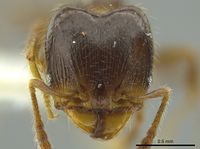 Pheidole boliviana, Major |
- Major: in full-face view, longitudinal carinulae originating on the posterior margin of the frontal triangle fail to reach all the way to the occipital margin . . . . . 160
160
return to couplet #159
- Major: promesonotal dorsum entirely covered by faint longitudinal carinulae (Colombia, Amazonian Brazil) . . . . . Pheidole guajirana
- Major: promesonotal dorsum lacks carinulae . . . . . 161
161
return to couplet #160
- Major: in full-face view, posterior half of head sprinkled with sparse but conspicuous foveae; in side view, promesonotal profile descends to metanotal groove by a nearly vertical face (Chiapas, Mexico) . . . . . Pheidole mackayi
 Pheidole xxx, Major |
- Major: in full-face view, posterior half of head lacks foveae; in side view, promesonotal profile descends to metanotal groove gently, forming an angle of about 135 degrees with the basal face of the propodeum . . . . . 162
162
return to couplet #161
- Major: seen in dorsal-oblique view (mesosoma rotated around long axis 45 degrees from top view), pronotal humerus surmounted by a subtriangular tooth; body color yellow (Colombia, Brazil) . . . . . Pheidole arhuaca (in part - also #100)
 Pheidole arhuaca, Major |
- Major: seen in dorsal-oblique view, humerus surmounted by a broad, evenly curved lobe; body color reddish brown (Costa Rica) . . . . . Pheidole scitula (=Pheidole boliviana)
 Pheidole boliviana, Major |
163
return to couplet #158
- Major: in full-face view, carinulae between eyes and frontal lobes extend posteriorly just to the level of the posterior margins of the eyes (Trinidad) . . . . . Pheidole tenerescens
 Pheidole tenerescens, Major |
- Major: in full-face view, carinulae between eyes and frontal lobes extend posteriorly beyond the posterior margin of the eye for a distance of at least the Eye Length . . . . . 164
164
return to couplet #163
- Major: in side view, propodeal spine forms a 90-degree angle with the basal face of the propodeum, and its tip is straight or curved slightly forward; in side view, profile of posterior half of dorsum of head, exclusive of the occiput, very slightly concave (Costa Rica) . . . . . Pheidole amabilis
 Pheidole amabilis, Major |
- Major: in side view, propodeal spine forms an angle of 135 degrees or more with the basal face of the propodeum, and its tip is either straight or curved slightly backward . . . . . 165
165
return to couplet #164
- Major: head yellow with large but fuzzily-bordered brown or dark yellow spot in the center of its dorsal surface . . . . . 166
- Major: head lacking a contrasting brown or dark yellow spot in the center of its dorsal surface . . . . . 170
166
return to couplet #165
- Major: in full-face view, head tricolored, with dark brown circular spot in center of head, the remaining posterior two-thirds yellowish brown, and the anterior third yellow (Amazonian Peru, Nicaragua) . . . . . Pheidole flavifrons
- Major: in full-face view, head bicolored, with contrasting spot in the center and the remainder concolorous brown or yellow . . . . . 167
167
return to couplet #166
- Major: seen in dorsal-oblique view (mesosoma rotated around long axis 45 degrees from top view), pronotal humerus surmounted by a small triangular tooth (Ecuador) . . . . . Pheidole viriosa (in part - also #103)
- Major: seen in dorsal-oblique view, pronotal humerus either obtusely sub angular or else smoothly rounded, not bearing a tooth . . . . . 168
168
return to couplet #167
- Major: shallow antennal scrobe present (Venezuela) (placed in the tristis group; also keyed out here to ensure identification) . . . . . Pheidole eparmata
 Pheidole eparmata, Major |
- Major: antennal scrobe absent . . . . . 169
169
return to couplet #168
- Major: seen from the side, propodeal spine slightly curved posteriorly; hairs on the dorsal profile of the promesonotum not exceeding 1.5 X the Eye Length (Panama) . . . . . Pheidole mallota
- Major: seen from the side, propodeal spine straight; some of the hairs on the promesonotal profile 2 X the Eye Length (Ecuador) . . . . . Pheidole ecuadorana
170
return to couplet #165
- Major: lower half of mesopleuron foveolate and opaque . . . . . 171
- Major: lower half of mesopleuron smooth and shiny . . . . . 172
171
return to couplet #170
- Major: seen from above, pronotal humeri extend out prominently to create subangulate profiles; body brownish yellow. Minor: seen from above and obliquely, humerus bears short obtuse-angular tooth from whose apex emerges a single long hair (southern Mexico, Costa Rica) . . . . . . Pheidole sagana (=Pheidole nitidicollis)
 Pheidole nitidicollis, Major |
- Major: seen from above, humeri not protuberant, and lateral margins of pronotum form near-perfect semicircles; body dark brown. Minor: humerus not surmounted by piligerous tooth (Costa Rica) . . . . . Pheidole lustrata
 Pheidole lustrata, Major |
172
return to couplet #170
- Major: seen from above, transverse carinulae cover anterior fringe of the pronotal dorsum . . . . . 173
- Major: pronotal dorsum free of carinulae . . . . . 174
173
return to couplet #172
- Major: in side view, the propodeal spiracle is longer than the height of the propodeal spine, which is short and has the outline of an equilateral triangle (Costa Rica, Nevis and Jamaica in West Indies) . . . . . Pheidole nitidicollis
 Pheidole nitidicollis, Major |
- Major: in side view the spiracle is small, much shorter than the height of the needle-shaped propodeal spine (Bolivia, Peru, Argentina) (placed in the tristis group; also keyed out here to ensure identification) . . . . . Pheidole nigella
 Pheidole nigella, Major |
174
return to couplet #172
- Major: seen in dorsal-oblique view (mesosoma rotated around long axis 45 degrees from top view), profile of humerus forms a blunt, oblique angle; hairs lining dorsal profile of mesosoma (thorax plus propodeum) are short, not as long as eye; yellow (Brazil, Guyana) . . . . . Pheidole minutula
 Pheidole minutula, Major |
- Major: seen from dorsal-oblique view, profile of humerus lobose; many of the hairs lining dorsal profile of mesosoma longer than Eye Length; body dark brown . . . . . 175
175
return to couplet #174
- Major and minor: in side view, promesonotal profile rises slightly to a low but distinct obtuse angle at about the midpoint. Major: head bicolored, with anterior third brownish yellow and posterior two-thirds dark brown (Bolivia) . . . . . Pheidole delicata
- Major and minor: in side view, promesonotal profile smoothly rounded at the midpoint; head concolorous dark brown (Sao Paulo, Brazil) . . . . . Pheidole lucaris
 Pheidole lucaris, Major |



